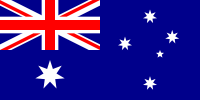
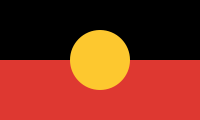
 |
 |
 |
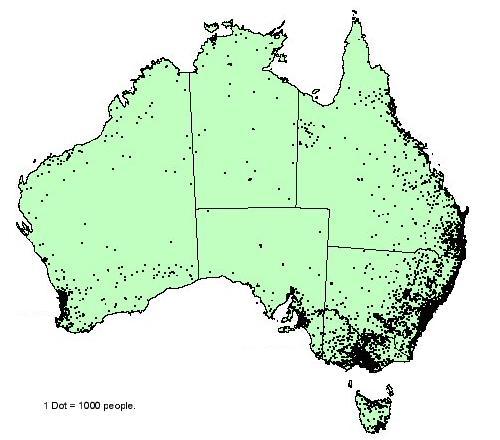 |
| Aboriginal settlement circa 1770 | Whole population in year 2000 |
The book I, The Aboriginal by Douglas Lockwood gives a full account of the operation. Douglas Lockwood is not the aboriginal, he was a journalist who created the book from interviews with the man, Waipuldanya. The full account of his circumcision ceremony covers many pages, but here are a few snippets.
p. 21 I think I was nine years old. My brother-in-law, Mardi, approached me stealthily from behind, blindfolded me with his hands, and said "Waipuldanya, your time has come. Barnabas, your father, has told the elders that his son is ready to be made a man."
p.22. "It is a time of banishment, of brutality, of monkish self-denial - and silence. In my case it involved circumcision with a razor-blade, without antiseptics or anaesthesia .....
I did not realize then that my circumcision was a relatively painless and particularly hygenic operation if compared to the methods used before the first coming of the white man. Among his gifts to us have been sharp implements. But my father was cut with a stone. My grandfather's operation was done by a surgeon who used his teeth!
.... my dressing was was a lump of white clay - margira - which dried and cracked in the sun and had to be replaced daily.
The dancing and ritual carried on for some days before the actual operation - some the boy was allowed to see, for others he was blindfolded.
p. 25. Two boys who have already been circumcised whisper some reassurance,
"Don't be afraid, don't cry out. Don't be weak like a woman. They will cut off your foreskin - it will hurt - but not enough to make you cry out - it will be over quickly."
p. 26. We regard The Snake as The Boss. His symbol is the rainbow. He is the Roadmaker, bringing young girls to puberty, forming the roads to their wombs so that spirit-children may pass to be born of the flesh. My people do not believe that conception occurs through sexual intercourse. It is achieved immaculately by the spirits.
p. 27. Dawn was breaking. A paperbark bed was prepared and my brother-in-law Mardi Mungudding lay face down upon it acting as a human mattress. .....
The Number One Dogman approached softly. I saw him looming above me, grotesquely painted but benevolent. "Bite hard on this" he said "it will help you not cry out". He handed me a crude dillybag made of grass, reeds and fabric. ....
I clenched the bag between my teeth and instantly felt the searing heat of cold steel as I was sanctified. The operation lasted less than a minute. It was painful, but I savaged my biting bag and did not cry out.
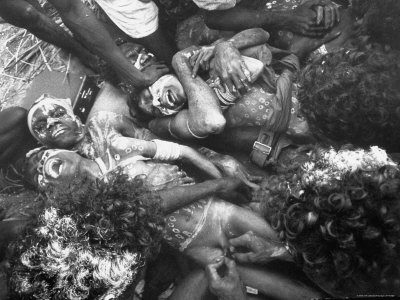 |
Australian aboriginal circumcision. Photograph by Fritz Goro, from LIFE magazine December 12, 1955 In this case the support men are lying face up, and the boys don't seem to be able to obey the injunction not to cry out. |
Some aboriginal people in north-west Australia practised an additional operation, subincision, carried out some time after circumcision. This involves an incision into the urethra from the underside of the penis, creating an artificial hypospadias. The extent of the cut is quite variable and some men would have it progressively lengthened in subsequent ceremonies. Robert Tonkinson, in 'The Mardudjara Aborigines' gives an account of the circumcision and subsequent subincision of a 16-year-old boy. To read an extract, click here
Subincision was only ever practised by a small minority of tribes, mostly in the north-west, but attracted a disproportionate amount of attention from anthropologists just because it was unusual. There is no evidence that it happens today.
Traditional circumcision certainly does continue in northern Australia, and doctors are now active in providing sterile instruments and dressings so that the traditional ceremonies can continue with less risk of infection.
When the first convicts and free settlers came to Australia the only circumcised men were Jewish - there were 8 Jewish convicts in the First Fleet. In total it is estimated that about 1,000 Jewish convicts came to Australia duing the 60 years of transportation. They were overwhelmingly male - only 70 women were in that number. This means that at first there would be little demand for circumcision since, strictly at least, Judaism is only passed through the female line. However, by 1820 Jewish associations were being formed, and circumcision for Jewish boys was being advertised in the newspapers by the middle of the century.
In Britain, in the late 19th century, circumcision became popular among the upper classes, following on the trend set by royalty. In the early 20th century the practice trickled down to the aspiring middle classes, and stopped there. The difference was quite stark. In the USA circumcision was taking off at the same time but in that more egalitarian society there was less of a class divide, though there were ethnic differences. Australia was more influenced by Britain than the US, but with the health and hygiene benefits being touted by both the major English speaking countries it was inevitable that Australia would also adopt circumcision.
In 1903 Philip Muskett, in his two-volume 'Australian Medical Guide' inclded an article "How the Australian climate demands circumcision". He wrote "In this semi-tropical Australian climate of ours, it would be infinitely better if circumcision were the rule and not the exception." So at this date it was still the exception, but that rapidly changed. He also wrote "I may say that hundreds of male patients have told me how much they bitterly regretted that circumcision had not been performed on them, when they were young. But never yet have I met with a single individual who was sorry that he had been circumcised." You can read the whole article here. However, Australia is even more fiercely egalitarian than the US and so circumcision had to be available to everyone, not just the upper and middle classes as in England. It became well-nigh universal among anglo-irish Australians. There have been many reports of parents in the 1940s and 1950s not even being asked - the babies were just done automatically. Many European migrants were less accepting of circumcision, so there was bit of a divide between "new" and "old" Australians. Chinese Australians, on the other hand, generally adopted it.
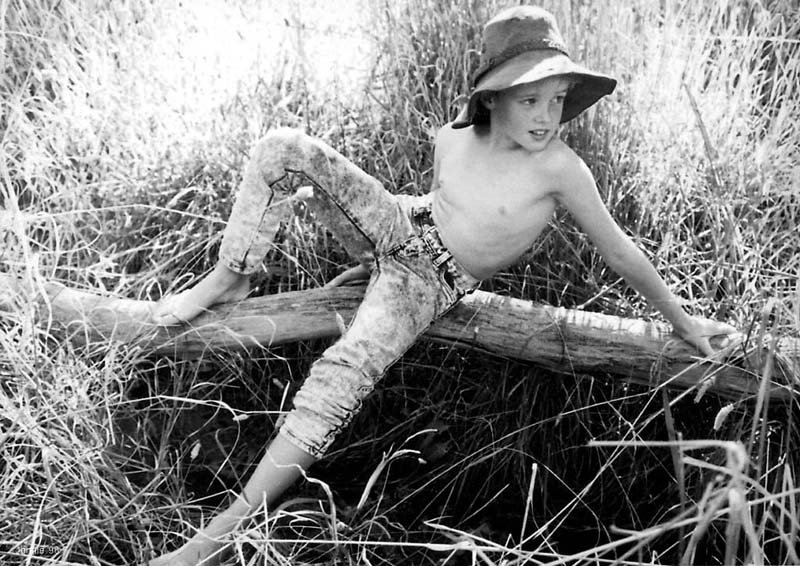
There is no doubt that there are national styles of circumcision. Of course you willl find 'high', 'low', 'tight' and 'loose' in every circumcising country, but there always seems to be a predominant style, and that will reflect the favourite circumcision technique. English circumcisions were usually done by the time-honoured technique of tugging the skin forward, gripping it with forceps and cutting it off in front of the forceps. A lot of inner skin was therefore retained, and a circumcised boy would have a bare glans, with a bunch of skin behind it, when flaccid. With an erection one could see the circumcision scar (usually very inconspicuous) about half-way up the shaft. The skin on the shaft was still freely mobile.
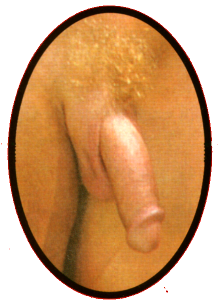 |
Australian circumcisions (see left) tended to the other extreme, with no loose skin on the shaft when flaccid and the skin stretched dead tight with an erection. In James Badger's survey for Forum magazine 72% of circumcised men had skin stretched tight when erect. You can read the whole survey on our surveys page . JB also wrote a piece for the Australian edition of Penthouse magazine which you can read here. In 1994 Australian Women's Forum (a shortlived spinoff from Forum magazine) ran a survey, which apparently had over a thousand respondents, on The Great Aussie Penis. 99% of the (female) respondents preferred a circumcised penis (a much larger percentage than in JB's survey). “AW”, age group 25-34, said “Very much circumcised, the tighter the better. Uncircumcised cocks are unhealthy and disgusting”. So it seems the tightly circumcised Aussie penis was a very good match to the desires of the Aussie girl. The picture here is from this article. One technique that was used for these dead-tight circumcisions is quite well known, and was published in England over a century ago. It is essentially a variant on traditional Jewish techniques. The initial cut is made with clamp forceps, as in the typical English cut, but then the remaining inner foreskin is trimmed away, leaving just a frill to attach to the outer skin. A full description is given in our Instruments and Techniques page. The scar will be ‘low’ and the cut will be ‘tight’ with little or no free skin. In the writer's experience (family and friends) that was the norm. But wider evidence shows that other techniques were used. In 1965 the Victorian branch of the Australian College of General Practitioners ran a study of circumcisions conducted by GPs. At the time they estimated that 60-70% of obstetric services in Australia were performed by GPs. This is a very high figure for that date, and certainly would not have been the case in the UK in 1965, nor in Australia 10 years later. For these GP circumcisions bone forceps were used in 59% of the cases. This is a 'tug and chop' procedure relying on the crushing effect of the forceps for haemostasis, and would give a 'high' cut with plenty of inner foreskin remaining. 31% used the 'Little Trimmer, an Aussie rip-off of the Gomco (see our Instruments and Techniques page). 11% used cutting and suturing (essentially as described above) and 1% did the same without suturing (as in a Jewish bris). One might suspect that the 30-40% of specialist obstreticians were more likely to use the more sophisticated cutting techniques. |
With no skin to move, it is not surprising that most Australian men (74% in James Badger's survey) masturbated using a lubricant. “As masturbation of an erect circumcised penis requires lubrication to be effective, and lubricants tend to be messy... manual sex play is restricted. A certain amount of dry masturbation is pleasant but after 30 seconds or so it becomes either painful or boring.” was one comment. Masturbation with lubricant is virtually unknown in Britain!
What about the US? There the almost universal Gomco clamp gives circular scars from 1 to 3 cm behind the glans, and a modest amount of skin movement - a style halfway between British and Aussie types, both in tightness and the amount of inner skin remaining. And it seems (naturally) that skin and lube wanking are about equally popular!
In the 1970s anti-circumcision articles started to appear in both medical journals and the popular press, initially without much effect. By the 1980s, though, circumcision rates were dropping dramatically, bottoming out at around 10%. The Australian Medical Assocoation and the Royal Australian College of Paediatricians both declared their opposition. Both public opinion and medical evidence started a movement in the opposite direction, and in 1999 the Royal Australian College of Surgeons, which had previously been silent, issued a statement saying that performing the procedure was at the discretion of parents and could be performed for religious, cultural, medical or social reasons. This prompted an article in the Sydney Sunday newspaper the Sun Herald saying that circumcision of baby boys was on the up again, with about 20% of parents requesting circumcision for their sons. Read the article here.
In 2006, the various state governments regulated that prophylactic circumcision could no longer be performed on the public hospital system. This seems to have made little difference to circumcision rates though it is manifestly unjust, hitting the poorer members of society. It seems that city hospitals, for whatever reason, were already reluctant to perform such circumcisions. And we may whisper that country hospitals may have been more willing to decree that circumcision was necessary for medical reasons.
By 2010 the Royal Australian College of Paediatricians had become a group within the Royal Australian College of Physicians, and this group modified their position:
“After reviewing the currently available evidence, the RACP believes that the frequency of diseases modifiable by circumcision, the level of protection offered by circumcision and the complication rates of circumcision do not warrant routine infant circumcision in Australia and New Zealand. However it is reasonable for parents to weigh the benefits and risks of circumcision and to make the decision whether or not to circumcise their sons. When parents request a circumcision for their child the medical attendant is obliged to provide accurate unbiased and up to date information on the risks and benefits of the procedure. Parental choice should be respected.”
This was a major backdown, even though the full report still contained many inaccuracies. You can access the whole report on the RACP website. File format is .pdf, download size is 448kB.
So where do we stand now? Overall, about 20% of newborn Australian boys are circumcised, but there is a big variation between states, from Tasmania where the rate is very low (and most circumcisions are performed in Victoria) to Queensland where it is about 30%. In NSW, the most populous state, the rate is about 20%, and that is probably also the national average. The traditional Aussie tight circumcision is becoming less prevalent since many doctors now use the Plastibell which gives a looser result.
The most recent study of the population as a whole was the Australian Study of Health Relationships (ASHR) (the equivalent of the UK NATSAL), carried out in 2001-2002. It found that 58.7% of men aged 16-29 were circumcised. Looking just at Australian-born men the figure was 69.19%. The youngest age group - 16-19 - was the only group in which circumcised men were in the minority, at 31.64%. These teenagers were born post 1981 so it does suggest that the drop in newborn circumcisions was at least partly matched by an increase in later operations.
Douglas Lockwood, I the Aborginal. Adelaide & Sydney: Rigby, 1962
R.M. Fredman. Neonatal circumcision, a general practioner survey. Medical Journal of Australia, January 18th 1969, 117-120
James Badger. Circumcision - what you think. Australian Forum 2 (11), 1989. 10-29.)
The original questionnaire was published in Volume 2 Number 1, 1988.
Aileen Keating, The long and short of it. Australian Women's Forum. April 1994, pages 43-47
Juliet Richters et al, 2006. Circumcision in Australia and its effects on sexual health. International Journal of STDs and AIDS, 17547-554.
Australian Bureau of Statistics.
Maps courtesy of Baedeker and the Australian Bureau of Statistics. Note: The map showing areas of Aboriginal occupation pre-1788 is approximate. It lacks sufficient accuracy to be used for Land Rights Claim purposes.